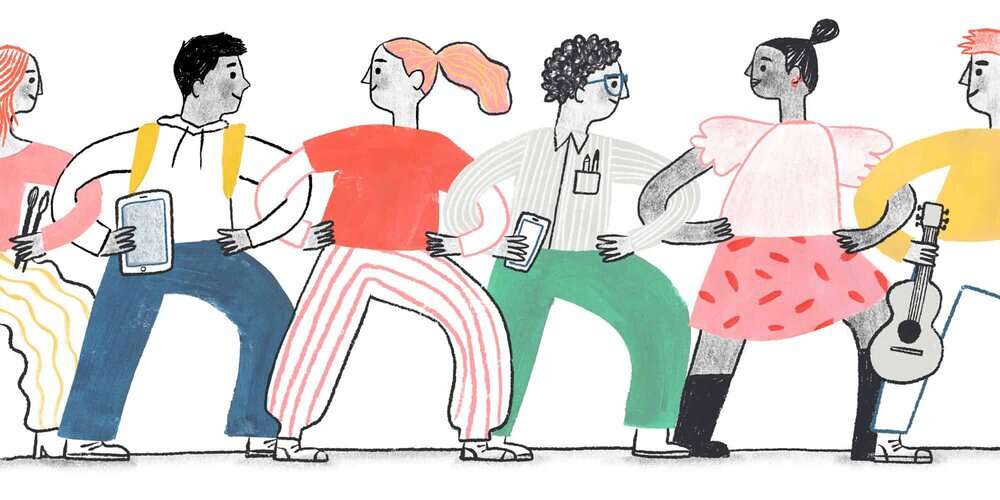Try Grounding Exercises

Grounding is a way to distract yourself from what’s going on inside you — your thoughts and feelings — and focus on what’s going on around you. Grounding helps you feel present in the moment rather than swimming in thoughts or being overwhelmed. You can use grounding anytime, anywhere.
Different grounding techniques use different parts of our brains and bodies. Some of them are physical and some are mental. All of them can help you feel more regulated and centered. A few different grounding techniques to try include:
10-1 shakeout
Stand with your feet shoulder-width apart and knees slightly bent. Lift your right hand and shake it 10 times, counting out loud from 10 down to 1. Do the same with your left hand, right leg, and left leg.
Do the exercise again, this time shaking your limbs 9 times each, counting out loud from 9 to 1. Continue to pick up speed as you make your way all the way down to 1.
At the end, stand with both feet firmly on the ground. Take a big inhale and reach your arms up. As you exhale, draw your palms together in front of your heart.
5-4-3-2-1
Stop and stand or sit still wherever you are. Notice:

Here’s an example if you’re sitting in your bedroom doing homework: “I see my pillow, my desk, my comforter, my shoes on the floor, and my backpack by the door. I feel my computer keypad, my fuzzy socks, my chair, and the breeze coming in through the open window. I hear music playing, someone clanging around in the kitchen, a car driving by. I smell the scent of fresh air and my sweatshirt that might possibly need to be washed. I taste the gum I am chewing.” As a bonus step, you can also write down what you see, feel, hear, smell, and taste.
Progressive muscle relaxation
Progressive muscle relaxation involves tensing and relaxing your muscles to help relieve physical tension throughout your whole body. Breathing in, you tighten a group of muscles and as you breathe out, you relax the same group of muscles. You start with your feet and progressively move up your body until you’ve worked on all of the major muscle groups.
Examples of muscle groups include feet, calves, thighs, lower back, abdomen, upper back, shoulders, arms, hands, neck, jaw, lips, eyes, and forehead.
To start, choose a comfortable position lying down or sitting.
- Breathe in and tense the first muscle group. Curl your toes and arch your feet.
- Hold for five to 10 seconds.
- Breathe out and relax your feet and toes.
- Pause for a few seconds, then move your attention slowly up your body to the next muscle group. Breathe in and tense, then breathe out and relax each area until you finish with your head.
Observe-touch-think-soothe
Observe
- Look at pictures of people or pets that you care about.
- Read something or narrate song lyrics aloud (pick something that isn’t school-related). See what the words sound like if you say them backwards!
Touch
- Touch things around you and notice how they feel in your hand: your bag, your phone, your shirt.
- Jump up and down. Notice how your feet feel when they are on and off the ground.
Think
- Think of something funny that happened in the last week.
- Think of your favorite things in five categories such as TV series, artists, bands, foods, and styles.
Soothe
- Plan a treat for yourself, like going to a coffee shop or listening to your favorite album or podcast.
- Say something kind and empowering to yourself like, “I’ve got this” or “I’m strong enough to get through this week.” Repeat it a few times.
- Savor the feeling of gratitude towards yourself. Appreciate yourself for who you are and acknowledge that just getting up and dressed when things are challenging is a win. Congratulate yourself when you accomplish a task or get through a difficult day!
Dropping anchor
When a boat needs to stay still on the water, it drops an anchor. To ground yourself, stand still or sit straight up and picture yourself dropping an anchor. Straighten your spine, feel your back, and roll your shoulders. Notice your breathing — are you breathing out of your mouth or your nose? Are you holding your breath or is it steady and regular? With steady breathing as you visualize, you should feel more anchored.










